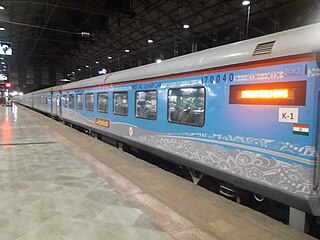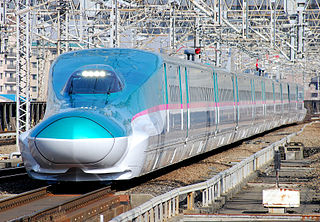
Rail transport in India consists of primarily of passenger and freight shipments along an integrated rail network. Indian Railways (IR), a statutory body under the ownership of the Ministry of Railways of the Government of India, operates India's national railway system. It is the primary owner and operator of rail operations throughout the country including suburban rail in major metros.

Indian Railways is a state-owned enterprise that is organised as a deparmental undertaking of the Ministry of Railways of the Government of India and operates India's national railway system. As of 2023, it manages the fourth largest national railway system by size with a track length of 132,310 km (82,210 mi), running track length of 106,493 km (66,172 mi) and route length of 68,584 km (42,616 mi). As of August 2024, 96.59% of the broad-gauge network is electrified. With more than 1.2 million employees, it is the world's ninth-largest employer and India's second largest employer.

Shatabdi Express are a series of fast passenger trains operated by Indian Railways. Shatabdi Express are day trains and mostly return to their origin station the same day. The trains run at a maximum permissible speed of 110–150 km/h (68–93 mph) with the Rani Kamalapati–New Delhi Shatabdi Express achieving the maximum permissible speed of 150 km/h (93 mph) between Tughlakabad and Bilochpura Agra.

Indian locomotive class WAP-5 is a class of electric locomotives used by Indian Railways. The first ten locomotives were imported from ABB in Switzerland in 1995 and later manufactured by Chittaranjan Locomotive Works in India. On 3 July 2014, a WAP-5 set an Indian speed record by hauling a train between Delhi and Agra at a speed of 160 km/h (99 mph). The locomotive has regenerative braking, flexible gear coupling, wheel-mounted disc brakes, and a potential for speed enhancement to 200 km/h (120 mph). Braking systems include 160 kN (36,000 lbf) regenerative brakes, disc brakes, automatic train air brakes and a charged spring parking brake.

The 12001/02 Rani Kamlapati (Habibganj)-New Delhi Shatabdi Express is a train operated by the Northern Railways which runs between New Delhi, the main railway station of India's capital territory, New Delhi, and Rani Kamlapati (Habibganj) Railway Station, the suburban railway station of Bhopal, the state capital of the central Indian state of Madhya Pradesh. It is one of the fastest train in India with a maximum permissible speed of 150 km/h (93 mph).

India has a system of express trains, operated by Indian Railways which comes under the purview of the Ministry of Railways of Government of India. As of 2023, it maintains over 108,706 km (67,547 mi) of tracks, spanning across 68,584 km (42,616 mi) in route length, and operates nearly 3,000 express trains daily. According to the Ministry of Railways, express trains travel faster and have limited stops than ordinary passenger trains. Any passenger train with an average speed higher than 55 km/h (34 mph) is considered super-fast.

Mumbai–Ahmedabad High Speed Rail Corridor (MAHSR) or Mumbai–Ahmedabad HSR is an under-construction high-speed rail line, which will connect Mumbai, the financial hub of India, with Ahmedabad, the largest city in the state of Gujarat. When completed, it will be India's first high-speed rail line, with a top speed of 320 km/h (200 mph).

Higher-speed rail (HrSR), also known as high-performance rail, higher-performance rail, semi-high-speed rail or almost-high-speed rail, is the jargon used to describe inter-city passenger rail services that have top speeds of more than conventional rail but are not high enough to be called high-speed rail services. The term is also used by planners to identify the incremental rail improvements to increase train speeds and reduce travel time as alternatives to larger efforts to create or expand the high-speed rail networks.

The 12049 / 12050 Gatiman Express is an express train run by Indian Railways. It connects Hazrat Nizamuddin in Delhi and Jhansi railway stations.
The Indian Government is undertaking several initiatives to upgrade its aging railway infrastructure and enhance its quality of service. The Railway Ministry has announced plans to invest ₹5,400,000 crore to upgrade the railways by 2030. Upgrades include 100% electrification of railways, upgrading existing lines with more facilities and higher speeds, expansion of new lines, upgrading railway stations, introducing and eventually developing a large high-speed train network interconnecting major cities in different parts of India and development of various dedicated freight corridors to cut down cargo costs within the country.

The Tejas Express is a semi-high speed fully air-conditioned train introduced by Indian Railways. It features modern onboard facilities with doors which are operated automatically. Tejas means "sharpness", "lustre", or "brilliance" in many Indian languages. It is one of 3 semi-high speed trains running in India, the others being the Vande Bharat Express and the Gatimaan Express.

The Vande Bharat sleeper trainset, formerly known as Train-20 is a semi-high-speed, long-distance electric multiple unit (EMU) train, designed to replace the Rajdhani Express. It is being developed based on the existing short-distance Vande Bharat trainset, differing in exterior body, sleeping berths, and onboard amenities due to its long-distance service.

Vande Bharat Express is a medium to long-distance superfast express service operated by Indian Railways. It is a reserved, air-conditioned chair car service connecting cities that are less than 800 km (500 mi) apart or take less than ten hours to travel with existing services and a planned reserved, air-conditioned sleeper service connecting cities that are 800 km (500 mi) to 1,200 km (750 mi) apart. The train was a part of the 'Make in India' initiative by the government and entered commercial service on 15 February 2019.
The Chennai-Mysuru high speed rail corridor is India's third high-speed rail project after the Mumbai Ahmedabad High Speed Rail Corridor and Delhi Varanasi High Speed Rail Corridor. The 435 km HSR corridor will connect Chennai to Mysuru through 9 stations.

KAVACH is an Automatic Train Protection (ATP) system indigenously developed by Research Designs & Standards Organisation (RDSO) in collaboration with Medha Servo Drives, Kernex Microsystems and HBL Power Systems. Initially it was known by the name Train Collision Avoidance System (TCAS). Kavach was adopted by Ministry of Railways as the National ATP System in July 2020.

The 22436/22435 New Delhi - Varanasi Jn Vande Bharat Express is India's 1st semi-high speed, electric multiple unit train, connecting the states of New Delhi and Uttar Pradesh.

The Vande Bharat trainset, formerly known as Train 18, is an Indian electric multiple unit chair car trainset designed and developed by Indian Railways at its Integral Coach Factory in Chennai. The train achieved a maximum speed of 183 km/h (114 mph) during its trial runs but the operational speed of the train is restricted to 160 km/h (99 mph) due to tracks' inability to support such speeds.

The 15557/15558 Darbhanga - Anand Vihar Terminal Amrit Bharat Superfast Express is India's 1st Non-AC Amrit Bharat Superfast Express train, which runs across the states of Bihar, Uttar Pradesh and New Delhi connecting the cities of Darbhanga and New Delhi's Anand Vihar Terminal via raxaul, sitamhari, gorakhpur, Lucknow, Kanpur.

Namo Bharat Rapid Rail is a short-distance service that operates on an inter-city rail network to connect major cities within a distance of around 100–250 km (62–155 mi). RCF Kapurthala, had rolled out the first Basic Unit of Namo Bharat Rapid Rail in April 2024. This train will be part of the 'Make in India' initiative by the Government of India and entered commercial service in September 2024.

































